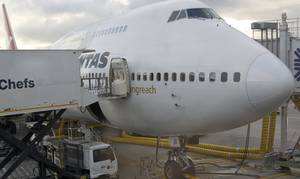Many people think flight attendants are glorified waitresses, but nothing is further than the truth. Cabin crew members are highly trained individuals who go through a rigorous training program before they ever take to the skies. Just what are they learning during those four to eight weeks of training? I think you’ll be surprised.
City Codes
Flight attendants have to memorize the three-letter identifier for every city their carrier operates out of. For international airlines, this can mean hundreds of codes. Some of them are easy, such as ZUR for Zurich. Others, not so much. Many flight attendants come up with clever sayings to help them remember the codes. Did you know Smurfs live in Sacramento (SMF)?
Serving Procedures
Believe it or not, there is a right and a wrong way to serve beverages and meals during a flight. There is even a right way to take meal orders in first class. On even-numbered flights, orders are taken from front to back. On odd-numbered flights, orders are taken from back to front. Passengers who fly often know this and choose their seats accordingly. Hot towels should always be passed in first class and usually in coach on international flights. Flight attendants practice walking up and down the aisle carrying drinks and meals so they can get used to the small confines of the cabin. Practice makes perfect, and no one wants to be spilled on.
Aircraft
Most airlines fly several different aircraft types. Flight attendants are required to learn each plane inside and out. This includes the location and operation of all doors, windows, emergency equipment, etc. While this may not seem difficult, it can be challenging. Everything has its place, and it is different on each plane. My former carrier operated nine different planes. With numerous pieces of equipment and exits, that’s a lot to learn.
Evacuations
Flight attendants must be able to evacuate a full plane within 90 seconds, so they have to know the location and operation of the exits like the back of their hand. There are also specific commands that must be learned. Most airlines also have overwater training during which crew members evacuate into a pool and get themselves and others into a life raft. Flight attendants practice simulated crashes over and over until they can initiate an evacuation in their sleep.
Emergency Equipment
Every plane has fire extinguishers (usually more than one type), portable oxygen, defibrillators, first aid kits, enhanced medical kits, and other pieces of emergency equipment. Flight attendants spend days learning the correct operation of this equipment as well as its location. They fight real fires in fire pits. They administer oxygen after mock decompressions. And they navigate through smoke-filled cabins.
Medical Procedures
Whom do you turn to if you become ill on the plane? Your flight attendant, of course. They are trained in CPR, rescue breathing, and how to deliver a baby (I actually did this!). They learn how to recognize the symptoms of a heart attack or stroke and know how to treat those conditions. Although not medical professionals, flight attendants can usually administer care until the plane is able to land. At 30,000 feet, flight attendants are your best bet for survival if you suffer a serious medical event.
Security
Security has always been touched on in fight attendant training. However, after September 11, it took on a whole new meaning. In the past, crew members were trained to comply, but no more. Days are spent learning how to detect risk, defuse violent situations, and thwart possible terrorist activities. Self-defense classes teach special techniques to be used in the aircraft environment. Flight attendants take security very seriously and are the last line of defense on the plane.
In additional to the items above, there are federal regulations to learn, company policies to memorize, grooming classes to attend, and customer service workshops. Classes are usually held five days a week with practice flights on the weekend. The days are long and the classes intense.
During the weeks of training, flight attendants are tested each day and must make a 90 or above on such tests to be successful. Most airlines allow for a few retakes, but the guidelines are strict. There are also hands-on drills for evacuations and medical situations. Those folks who come to training expecting it to be easy are usually disappointed and often unsuccessful. Being a flight attendant is a great career, but it is definitely a lot more than waitressing in the sky.





